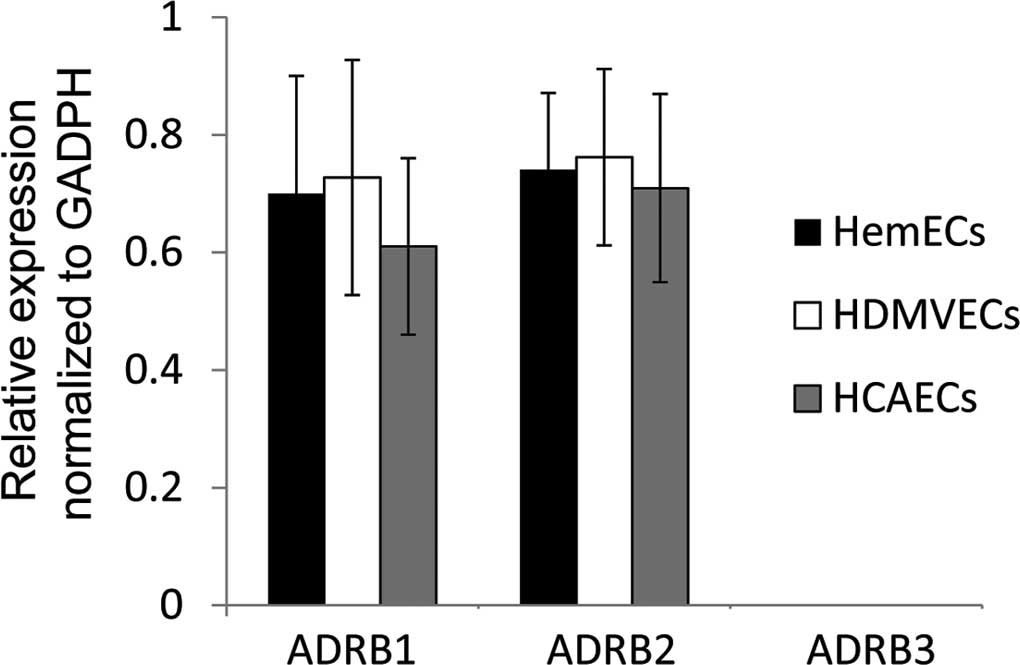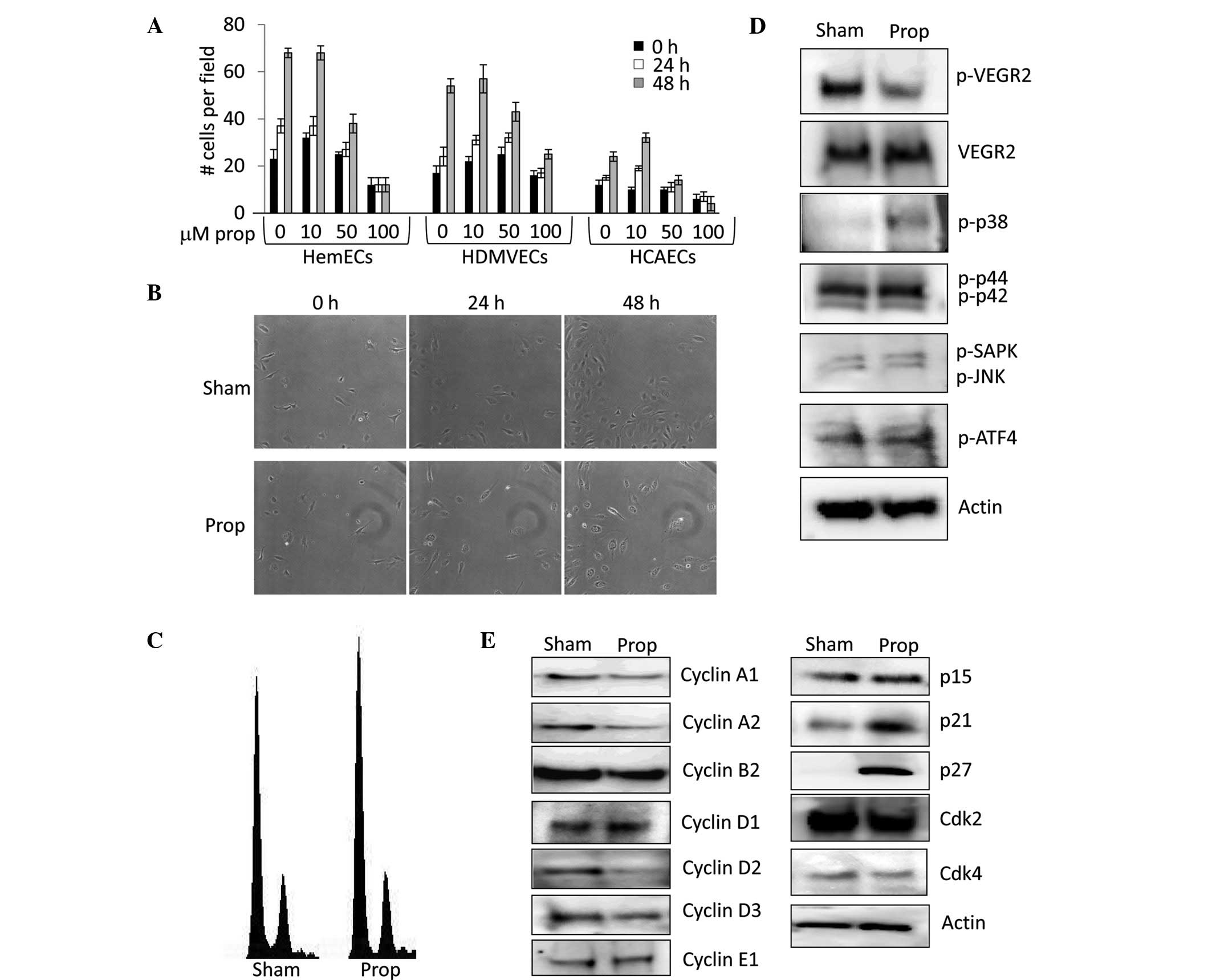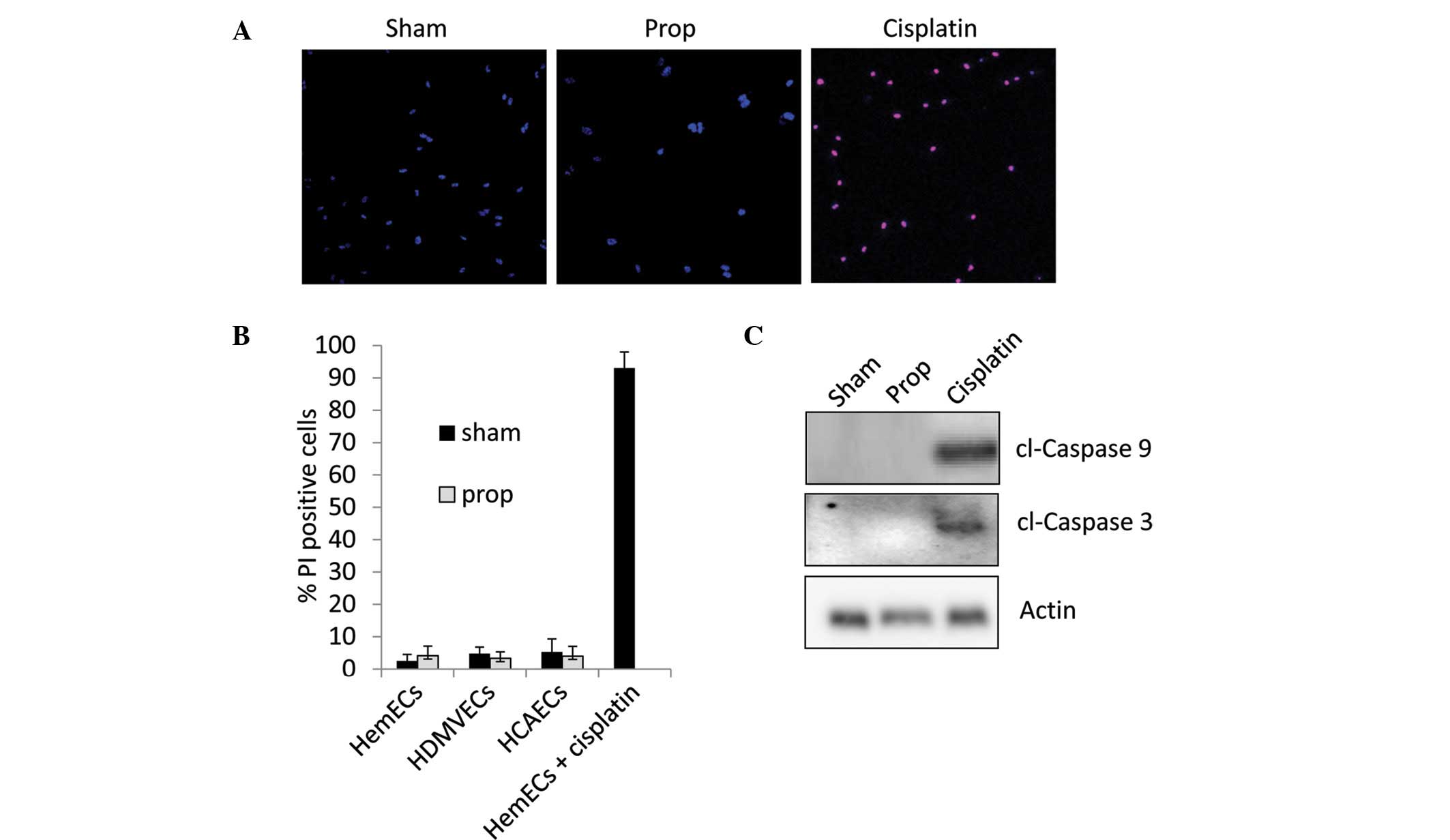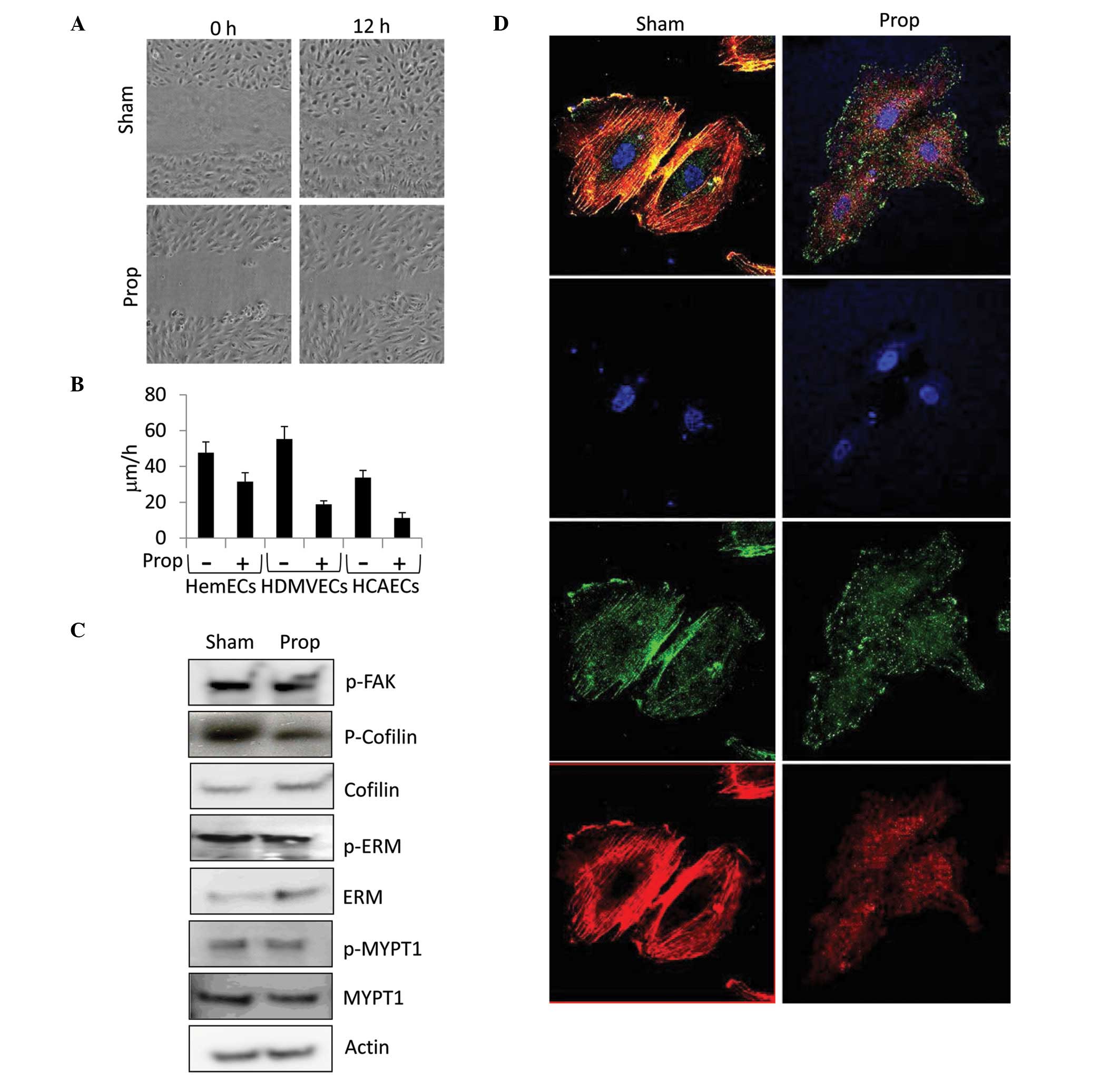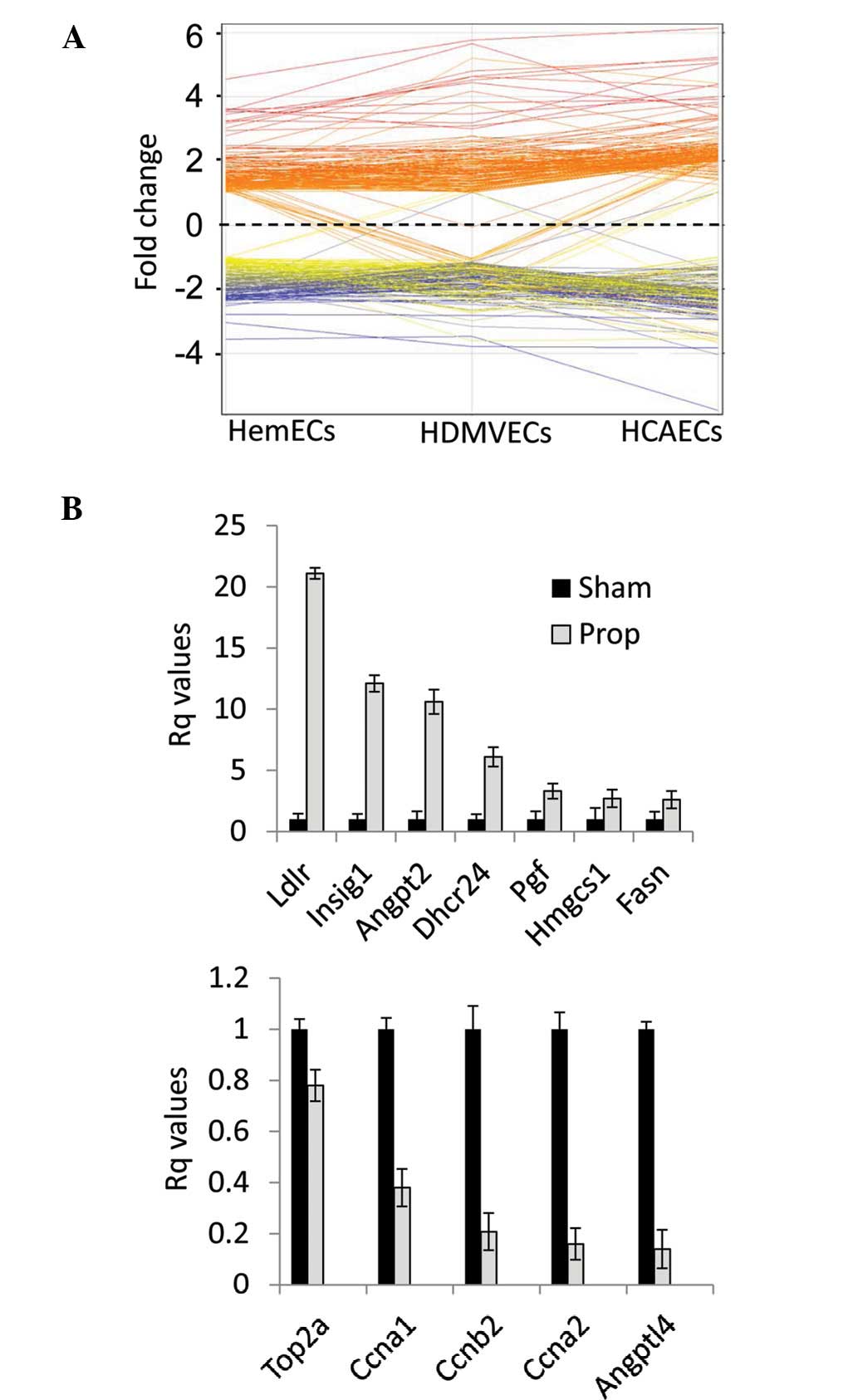|
1
|
Waner M, North PE, Scherer KA, Frieden IJ,
Waner A and Mihm MC Jr: The nonrandom distribution of facial
hemangiomas. Arch Dermatol. 139:869–875. 2003. View Article : Google Scholar : PubMed/NCBI
|
|
2
|
Léauté-Labrèze C, Dumas de la Roque E,
Hubiche T, Boralevi F, Thambo JB and Taïeb A: Propranolol for
severe hemangiomas of infancy. N Engl J Med. 358:2649–2651.
2008.PubMed/NCBI
|
|
3
|
D’Angelo G, Lee H and Weiner RI:
cAMP-dependent protein kinase inhibits the mitogenic action of
vascular endothelial growth factor and fibroblast growth factor in
capillary endothelial cells by blocking Raf activation. J Cell
Biochem. 67:353–366. 1997.
|
|
4
|
Sommers Smith SK and Smith DM: Beta
blockade induces apoptosis in cultured capillary endothelial cells.
In Vitro Cell Dev Biol Anim. 38:298–304. 2002.PubMed/NCBI
|
|
5
|
Lamy S, Lachambre MP, Lord-Dufour S and
Béliveau R: Propranolol suppresses angiogenesis in vitro:
inhibition of proliferation, migration, and differentiation of
endothelial cells. Vascul Pharmacol. 53:200–208. 2010. View Article : Google Scholar : PubMed/NCBI
|
|
6
|
Spindler V and Waschke J: Beta-adrenergic
stimulation contributes to maintenance of endothelial barrier
functions under baseline conditions. Microcirculation. 18:118–127.
2011. View Article : Google Scholar
|
|
7
|
Makarski JS: Stimulation of cyclic AMP
production by vasoactive agents in cultured bovine aortic and
pulmonary artery endothelial cells. In Vitro. 17:450–458. 1981.
View Article : Google Scholar : PubMed/NCBI
|
|
8
|
Welles SL, Shepro D and Hechtman HB:
Vasoactive amines modulate actin cables (stress fibers) and surface
area in cultured bovine endothelium. J Cell Physiol. 123:337–342.
1985. View Article : Google Scholar : PubMed/NCBI
|
|
9
|
Brehm BR, Bertsch D, von Fallois J and
Wolf SC: Beta-blockers of the third generation inhibit endothelin-1
liberation, mRNA production and proliferation of human coronary
smooth muscle and endothelial cells. J Cardiovasc Pharmacol.
36(Suppl 1): S401–S403. 2000. View Article : Google Scholar : PubMed/NCBI
|
|
10
|
Dai Y, Hou F, Buckmiller L, Fan CY, Saad
A, Suen J and Richter GT: Decreased eNOS protein expression in
involuting and propranolol-treated hemangiomas. Arch Otolaryngol
Head Neck Surg. 138:177–182. 2012. View Article : Google Scholar : PubMed/NCBI
|
|
11
|
Chim H, Armijo BS, Miller E, Gliniak C,
Serret MA and Gosain AK: Propranolol induces regression of
hemangioma cells through HIF-1alpha-mediated inhibition of VEGF-A.
Ann Surg. 256:146–156. 2012. View Article : Google Scholar : PubMed/NCBI
|
|
12
|
Boye E, Yu Y, Paranya G, Mulliken JB,
Olsen BR and Bischoff J: Clonality and altered behavior of
endothelial cells from hemangiomas. J Clin Invest. 107:745–752.
2001. View
Article : Google Scholar : PubMed/NCBI
|
|
13
|
Lichtenstein N, Geiger B and Kam Z:
Quantitative analysis of cytoskeletal organization by digital
fluorescent microscopy. Cytometry A. 54:8–18. 2003. View Article : Google Scholar : PubMed/NCBI
|
|
14
|
Howell RE, Albelda SM, Daise ML and Levine
EM: Characterization of beta-adrenergic receptors in cultured human
and bovine endothelial cells. J Appl Physiol. 65:1251–1257.
1988.PubMed/NCBI
|
|
15
|
Jinnin M, Medici D, Park L, Limaye N, Liu
Y, Boscolo E, Bischoff J, Vikkula M, Boye E and Olsen BR:
Suppressed NFAT-dependent VEGFR1 expression and constitutive VEGFR2
signaling in infantile hemangioma. Nat Med. 14:1236–1246. 2008.
View Article : Google Scholar : PubMed/NCBI
|
|
16
|
Souza BR, Santos JS and Costa AM: Blockade
of beta1- and beta2-adrenoceptors delays wound contraction and
re-epithelialization in rats. Clin Exp Pharmacol Physiol.
33:421–430. 2006. View Article : Google Scholar : PubMed/NCBI
|
|
17
|
Romana-Souza B, Santos JS and
Monte-Alto-Costa A: beta-1 and beta-2, but not alpha-1 and alpha-2,
adrenoceptor blockade delays rat cutaneous wound healing. Wound
Repair Regen. 17:230–239. 2009. View Article : Google Scholar : PubMed/NCBI
|
|
18
|
Romana-Souza B, Porto LC and
Monte-Alto-Costa A: Cutaneous wound healing of chronically stressed
mice is improved through catecholamine blockade. Exp Dermatol.
19:821–829. 2010. View Article : Google Scholar : PubMed/NCBI
|
|
19
|
Romana-Souza B, Otranto M, Vieira AM,
Filgueiras CC, Fierro IM and Monte-Alto-Costa A: Rotational
stress-induced increase in epinephrine levels delays cutaneous
wound healing in mice. Brain Behav Immun. 24:427–437. 2010.
View Article : Google Scholar : PubMed/NCBI
|
|
20
|
Romana-Souza B, Nascimento AP and
Monte-Alto-Costa A: Propranolol improves cutaneous wound healing in
streptozotocin-induced diabetic rats. Eur J Pharmacol. 611:77–84.
2009. View Article : Google Scholar : PubMed/NCBI
|
|
21
|
Romana-Souza B, Nascimento AP and
Monte-Alto-Costa A: Low-dose propranolol improves cutaneous wound
healing of burn-injured rats. Plast Reconstr Surg. 122:1690–1699.
2008. View Article : Google Scholar : PubMed/NCBI
|
|
22
|
Mohammadi AA, Bakhshaeekia A, Alibeigi P,
Hasheminasab MJ, Tolide-ei HR, Tavakkolian AR and Mohammadi MK:
Efficacy of propranolol in wound healing for hospitalized burn
patients. J Burn Care Res. 30:1013–1017. 2009.PubMed/NCBI
|
|
23
|
Musumeci M, Maccari S, Sestili P, Signore
M, Molinari P, Ambrosio C, Stati T, Colledge WH, Grace AA, Catalano
L and Marano G: Propranolol enhances cell cycle-related gene
expression in pressure overloaded hearts. Br J Pharmacol.
164:1917–1928. 2011. View Article : Google Scholar : PubMed/NCBI
|
|
24
|
Erraji-Benchekroun L, Couton D, Postic C,
Borde I, Gaston J, Guillet JG and André C: Overexpression of
beta2-adrenergic receptors in mouse liver alters the expression of
gluconeogenic and glycolytic enzymes. Am J Physiol Endocrinol
Metab. 288:E715–E722. 2005. View Article : Google Scholar : PubMed/NCBI
|
|
25
|
Patrizio M, Musumeci M, Stati T, Fecchi K,
Mattei E, Catalano L and Marano G: Propranolol promotes Egr1 gene
expression in cardiomyocytes via beta-adrenoceptors. Eur J
Pharmacol. 587:85–89. 2008. View Article : Google Scholar : PubMed/NCBI
|
|
26
|
Lashbrook BL and Steinle JJ:
Beta-adrenergic receptor regulation of pigment epithelial-derived
factor expression in rat retina. Auton Neurosci. 121:33–39. 2005.
View Article : Google Scholar : PubMed/NCBI
|
|
27
|
Haggstrom AN, Beaumont JL, Lai JS, Adams
DM, Drolet BA, Frieden IJ, Garzon MC, Holland KE, Horii KA, Lucky
AW, et al: Measuring the severity of infantile hemangiomas:
instrument development and reliability. Arch Dermatol. 148:197–202.
2012. View Article : Google Scholar : PubMed/NCBI
|
|
28
|
Boye E and Olsen BR: Signaling mechanisms
in infantile hemangioma. Curr Opin Hematol. 16:202–208. 2009.
View Article : Google Scholar : PubMed/NCBI
|
|
29
|
Grimmer JF, Williams MS, Pimentel R,
Mineau G, Wood GM, Bayrak-Toydemir P and Stevenson DA: Familial
clustering of hemangiomas. Arch Otolaryngol Head Neck Surg.
137:757–760. 2011. View Article : Google Scholar : PubMed/NCBI
|
|
30
|
Khan ZA, Boscolo E, Picard A, Psutka S,
Melero-Martin JM, Bartch TC, Mulliken JB and Bischoff J:
Multipotential stem cells recapitulate human infantile hemangioma
in immunodeficient mice. J Clin Invest. 118:2592–2599.
2008.PubMed/NCBI
|
|
31
|
Calicchio ML, Collins T and Kozakewich HP:
Identification of signaling systems in proliferating and involuting
phase infantile hemangiomas by genome-wide transcriptional
profiling. Am J Pathol. 174:1638–1649. 2009. View Article : Google Scholar : PubMed/NCBI
|
|
32
|
Iaccarino G, Ciccarelli M, Sorriento D,
Galasso G, Campanile A, Santulli G, Cipolletta E, Cerullo V, Cimini
V, Altobelli GG, et al: Ischemic neoangiogenesis enhanced by
beta2-adrenergic receptor overexpression: a novel role for the
endothelial adrenergic system. Circ Res. 97:1182–1189. 2005.
View Article : Google Scholar
|
|
33
|
Storch CH and Hoeger PH: Propranolol for
infantile haemangiomas: insights into the molecular mechanisms of
action. Br J Dermatol. 163:269–274. 2010. View Article : Google Scholar : PubMed/NCBI
|
|
34
|
Fredriksson JM, Lindquist JM, Bronnikov GE
and Nedergaard J: Norepinephrine induces vascular endothelial
growth factor gene expression in brown adipocytes through a
beta-adrenoreceptor/cAMP/protein kinase A pathway involving Src but
independently of Erk1/2. J Biol Chem. 275:13802–13811. 2000.
View Article : Google Scholar
|
|
35
|
Taylor MR: Pharmacogenetics of the human
beta-adrenergic receptors. Pharmacogenomics J. 7:29–37. 2007.
View Article : Google Scholar : PubMed/NCBI
|
|
36
|
Rohrer DK, Chruscinski A, Schauble EH,
Bernstein D and Kobilka BK: Cardiovascular and metabolic
alterations in mice lacking both beta1- and beta2-adrenergic
receptors. J Biol Chem. 274:16701–16708. 1999. View Article : Google Scholar : PubMed/NCBI
|
|
37
|
Krief S, Lönnqvist F, Raimbault S, Baude
B, Van Spronsen A, Arner P, Strosberg AD, Ricquier D and Emorine
LJ: Tissue distribution of beta 3-adrenergic receptor mRNA in man.
J Clin Invest. 91:344–349. 1993. View Article : Google Scholar : PubMed/NCBI
|
|
38
|
Yuan SM, Jiang HQ, Ouyang TX and Xing X:
The distribution and evolution of pericytes in infantile
hemangioma. Zhonghua Zheng Xing Wai Ke Za Zhi. 23:322–324. 2007.(In
Chinese).
|
|
39
|
Ferrari-Dileo G, Davis EB and Anderson DR:
Effects of cholinergic and adrenergic agonists on adenylate cyclase
activity of retinal microvascular pericytes in culture. Invest
Ophthalmol Vis Sci. 33:42–47. 1992.
|
|
40
|
Siegfried EC, Keenan WJ and Al-Jureidini
S: More on propranolol for hemangiomas of infancy. N Engl J Med.
359:2846author reply 2846–2847, 2008.
|
|
41
|
Thaker PH, Han LY, Kamat AA, Arevalo JM,
Takahashi R, Lu C, Jennings NB, Armaiz-Pena G, Bankson JA, Ravoori
M, et al: Chronic stress promotes tumor growth and angiogenesis in
a mouse model of ovarian carcinoma. Nat Med. 12:939–944. 2006.
View Article : Google Scholar : PubMed/NCBI
|
|
42
|
Yang H, Xu Z, Iuvone PM and Grossniklaus
HE: Angiostatin decreases cell migration and vascular endothelium
growth factor (VEGF) to pigment epithelium derived factor (PEDF)
RNA ratio in vitro and in a murine ocular melanoma model. Mol Vis.
12:511–517. 2006.
|
|
43
|
Schieven GL: The biology of p38 kinase: a
central role in inflammation. Curr Top Med Chem. 5:921–928. 2005.
View Article : Google Scholar : PubMed/NCBI
|
|
44
|
Bamburg JR and Wiggan OP: ADF/cofilin and
actin dynamics in disease. Trends Cell Biol. 12:598–605. 2002.
View Article : Google Scholar : PubMed/NCBI
|
|
45
|
Arber S, Barbayannis FA, Hanser H,
Schneider C, Stanyon CA, Bernard O and Caroni P: Regulation of
actin dynamics through phosphorylation of cofilin by LIM-kinase.
Nature. 393:805–809. 1998. View
Article : Google Scholar : PubMed/NCBI
|
|
46
|
Street CA and Bryan BA: Rho kinase
proteins – pleiotropic modulators of cell survival and apoptosis.
Anticancer Res. 31:3645–3657. 2011.
|
|
47
|
De Giorgi V, Gandini S, Grazzini M,
Benemei S, Marchionni N and Geppetti P: Beta-blockers: a new and
emerging treatment for melanoma. Recenti Prog Med. 103:11–16.
2012.(In Italian).
|
|
48
|
Lin X, Luo K, Lv Z and Huang J:
Beta-adrenoceptor action on pancreatic cancer cell proliferation
and tumor growth in mice. Hepatogastroenterology. 59:584–588.
2012.PubMed/NCBI
|
|
49
|
Jansen L, Below J, Chang-Claude J, Brenner
H and Hoffmeister M: Beta blocker use and colorectal cancer risk:
Population-based case-control study. Cancer. May 14–2012.(Epub
ahead of print).
|
|
50
|
Pérez Piñero C, Bruzzone A, Sarappa MG,
Castillo LF and Lüthy IA: Involvement of alpha2- and
beta2-adrenoceptors on breast cancer cell proliferation and tumour
growth regulation. Br J Pharmacol. 166:721–736. 2012.PubMed/NCBI
|
|
51
|
Chambers CB, Katowitz WR, Katowitz JA and
Binenbaum G: A controlled study of topical 0.25% timolol maleate
gel for the treatment of cutaneous infantile capillary hemangiomas.
Ophthal Plast Reconstr Surg. 28:103–106. 2012.
|















